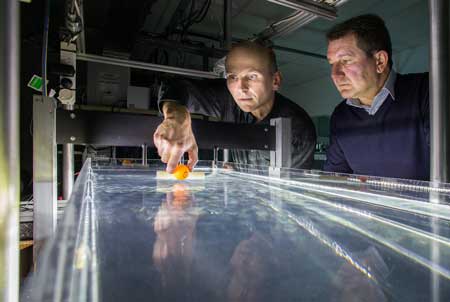| Posted: Feb 09, 2017 |
Scientists make new high-tech liquid metamaterials
(Nanowerk News) Scientists at The Australian National University (ANU) have controlled wave-generated currents to make previously unimaginable liquid materials for new technological innovations, including techniques to manipulate micro-organisms.
|
|
The new kind of dynamic material could be revolutionary, similar to other materials created in recent decades that have been used for invisibility cloaking, superlenses and high-efficiency antennae.
|
|
Research group leader Professor Michael Shats from ANU said the currents made a liquid behave like materials with regular structures such as crystals.
|
 |
| This is Dr Horst Punzmann (left) and Professor Michael Shats in the lab.
|
|
"It's an incredibly powerful new tool that will work at the surface of almost any liquid," said Professor Shats from the ANU Research School of Physics and Engineering.
|
|
"By changing waves, we can change the flow patterns. This allows us to remote-control the nature of the material."
|
|
The flow patterns can be changed at will, so the liquid-based materials are more dynamic and flexible than solid materials.
|
|
"These flow patterns are effectively two-dimensional materials at the interface between the liquid and the gas above it," Professor Shats said.
|
|
The research is published in Nature Communications ("Wave-based liquid-interface metamaterials").
|
|
Lead author Dr Nicolas Francois from the ANU Research School of Physics and Engineering said each current was like a Lego brick.
|
|
"Now we have created the brick, people will be able to make complex structures we cannot imagine now," he said.
|
|
"If you use conducting liquids you can create an interface with designed electrical properties. Or with biocompatible substances you can guide micro-organisms or trap them."
|
|
The team observed the flow patterns in a tank of water by generating a wave pattern with two oscillators and tracking fluid particles. They also modelled the flow with computer simulations and theoretical calculations.
|

